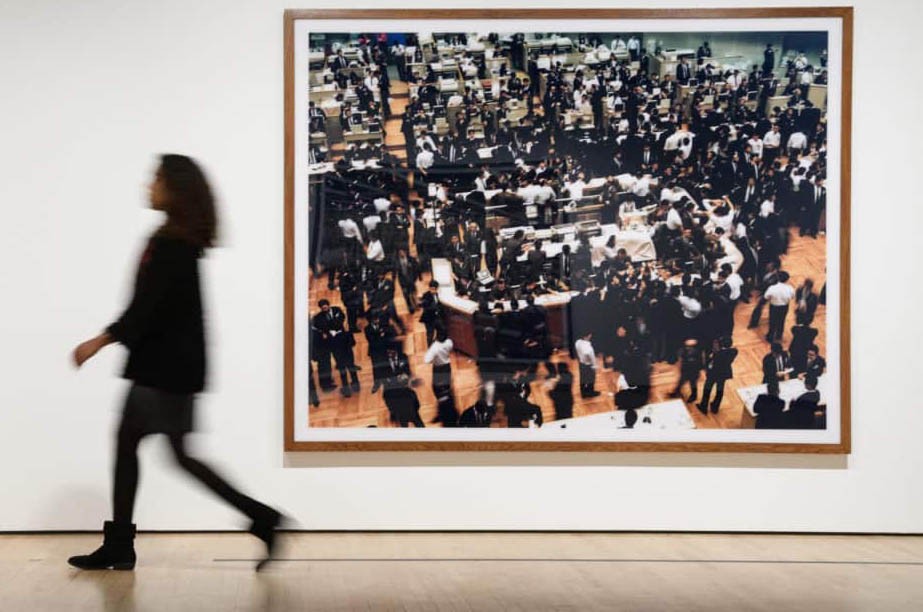
Inside the Hayward Gallery at the Southbank Centre, you can gaze at photographer Andreas Gursky’s frames with awe

I wonder how many times I am in someone else’s photograph without meaning to be: A faceless passerby, the blurry image of a woman walking across a frame -- a victim of time and circumstance, cut down to size. I wonder what it would be like to see all these pictures together. Testimonies to my random existence, random presence: a dispassionate permutation.
While the drama of our little lives plays out in the high octaves and burns brighter than a crimson tropical sun, to imagine ourselves as little more than props in the aesthetic scheme of a photo… a grand festival of nothingness.
The eye cuts through experiences and scenery; a camera as mimicry and compliment zeros in further. The result is a clearer totality, a postcard image -- the neat prettiness of a frame. This is the gaze of love. Clean-cut borders demarcate the field of vision and flatten the lover’s universe. An imagined omniscient, in contrast, leans back to gaze fully and deeply at the bigger picture. Photographer Andreas Gursky gazes at the world with the eyes of the all-encompassing. Inside the Hayward Gallery at the Southbank Centre, you can gaze back.
His gargantuan prints of haunting landscapes and human activity transfix and inspire awe. Gursky’s work is not just an act in defiance of a hierarchical world but an ode to an omniscient that sees beyond the utility of the very many subjects featuring in a photograph. Beyond the aesthetic component lies the photographer’s compassion. The photographs, as he intended them to be, are "read line by line". Even for the uninitiated observer, the impulse is to view Gursky’s photographs from afar and move in gradually.
One photograph, ‘Paris, Montparnasse’ (1993), the largest residential apartment building in Paris, is the juxtaposition of two different vantage points from just across the street. Individual dramas play out beautifully and in precise detail in the little windows of this imposing structure. The sometimes drawn and, at other times, pulled-back curtains allow a chance to peek into the lives of the building’s residents. This disembodied perspective affords the opportunity to reflect on the many uniquely distinct, complex and rich storylines of residents that may never find an obvious intersection; and which, for all intents and purposes, continue instead to run parallel to each other. Without a specific element of focus, you are free to engage with the photographs as you wish.
Walking across the gallery, with imposing backdrops of glaciers, mountains and tulip gardens among other sceneries hanging from the walls is an other-worldly experience. There is a sense of liberation, of inclusivity -- of being seen. Of being a mysterious and tantalising force sauntering about in the gallery, potentially stirring Gursky into his next artistic adventure. You imagine him looking at the gallery. You imagine yourself in his photographs. As it goes, no muse is good muse.
Gursky’s pieces are approximations of reality instead of documentations. They are attempts to reconstruct what exists by way of meshing the micro and macro together. In ‘Tokyo, Stock Exchange’ (1989), traders on the trading floor are captured at work, in their element. Individuals might figure as cogs in a giant machine in the photograph but Gursky indulges their uniqueness and specificity even as he aspires to an aesthetic that falls outside of the ambit of the traditional canon. His poetic, ‘painterly view of the world’ facilitates his pursuit to make sense of reality. He understands by way of revisiting, reconstructing and realigning.
Reality, for him, is located on the threshold between imagination and what exists. Even when his photographs are those of landscapes, they are commentaries on how we relate to the world around us -- striking mountains and spell-binding sceneries do not exist merely as photographic representations or simulations inspiring the same awe and wonder that they would in real life, but these make one think of the ways in which landscapes have been altered by humans.
The topsy-turvy race-track in Bahrain I (2005), as an example, appears to be a large asphalt snake captured wriggling on the beige sand. The contrast is striking and engaging. The picture has been visually treated, and like most of his work, made to appear real. An objective truth, as can be deduced from his work, is the least of his concerns.
Witnessing Gursky’s oeuvre spanning four decades within the confines of a gallery is an experience unto itself. It is startling how a skilfully-articulated idea can electrify a physical space. It is impossible to leave without a head full of ideas and questions about the ways in which one may see. But something else also happens when you walk about in that space: you feel seen. And it is one of those rare times that this happens without reducing your presence to a tragic or erotic code as a muse often boils down to.
Gursky’s imagined linear world humanises all that step into it. One can think of his work as a rejoinder to the totalising gaze of love. Neither a caustic affront nor a relentless spiel; but instead a subtle reflection on the tyranny of a lover’s vantage point -- brutalist, reductionist, celebratory, blurred by a school of red herring. The photographs, in their sheer scale and the field of vision that they encompass, appear to pose metaphors for the space one falls back into when love leaves. From where, once again, seeing is simultaneously a painful and pleasurable epiphany. Disorientating, inspiring, moving… It is a struggle to ground all of his work in a simplistic summary. It is a conversation. Or the beginning of one.
The exhibition started on January 25 and will be on till April 22, 2018